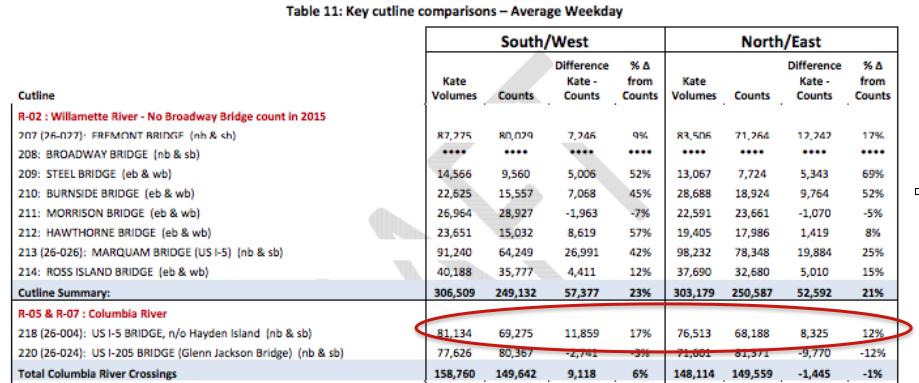What City Observatory Did This Week
Forecasting the impossible: The case for the $7.5 billion Interstate Bridge Replacement project is based on deeply flawed traffic models that ignore the bridge’s capacity limits, and predict plainly unrealistic levels of traffic growth if the bridge isn’t expanded. These grossly overestimated projections make future traffic look worse and overstate the need and understate the environmental and financial costs associated with freeway expansion.
The current I-5 bridge can carry no more than 5,000 vehicles northbound in the afternoon peak hour. All of the available statistics, and every one of the experts that has looked at the bridge has concluded that it is already operating at its maximum capacity.
 But Metro’s regional travel demand model, Kate, pretends that the bridge now carries more than 6,200 vehicles per hour–a thousand more cars and trucks per hour than can actually fit across the bridge. And the Kate model, used for the IBR environmental analysis, makes the absurd prediction that peak hour PM traffic will increase further beyond its capacity—even if the IBR project isn’t built.
But Metro’s regional travel demand model, Kate, pretends that the bridge now carries more than 6,200 vehicles per hour–a thousand more cars and trucks per hour than can actually fit across the bridge. And the Kate model, used for the IBR environmental analysis, makes the absurd prediction that peak hour PM traffic will increase further beyond its capacity—even if the IBR project isn’t built.
The Interstate Bridge Project’s Flawed Traffic Data. The Interstate Bridge Replacement Project simply can’t tell the truth about current traffic levels or recent growth rates. IBR reports inflate the current level of traffic on I-5 bridges by nearly 5,000 vehicles per day.
The IBR has variously claimed 142,400 or 143,400 vehicles per average weekday in 2019. Meanwhile, ODOT’s automatic traffic recorder reports 138,780 per day for the same year. That’s a discrepancy of up to 4,620 vehicles per day—not exactly a rounding error when you’re justifying a multi-billion dollar project.
IBR reports falsely claim that I-5 bridge traffic is growing twice as fast as ODOT’s own data show. IBR officials have exaggerated traffic levels and traffic growth rates to try to sell an over-sized, over-priced project.
Kate: Metro’s wildly inaccurate model overstates current traffic levels. The case for the $7.5 billion Interstate Bridge Replacement Project is based on traffic projections from Metro’s “Kate” travel demand model. But there’s a huge problem: Kate doesn’t accurately model even current levels of traffic. The model has a high overall error factor, and importantly, consistently over-estimates traffic on the existing I-5 bridges.
Metro has prepared a validation report—not published on its website—showing the Kate model assigns vastly more traffic to I-5 than actually use the bridge. The model essentially adds 20,000 non-existent cars and trucks to I-5 each day in 2019—more than 6 million vehicles annually. It’s hard to believe that Kate can predict future travel levels when it can’t accurately estimate current traffic volumes within a 20 percent error range.
In the News
Dissent published “Highway Robbery” Ben Ross and Joe Cortright’s article exposing the deep rot in traffic modeling used to justify highway expansion projects.



